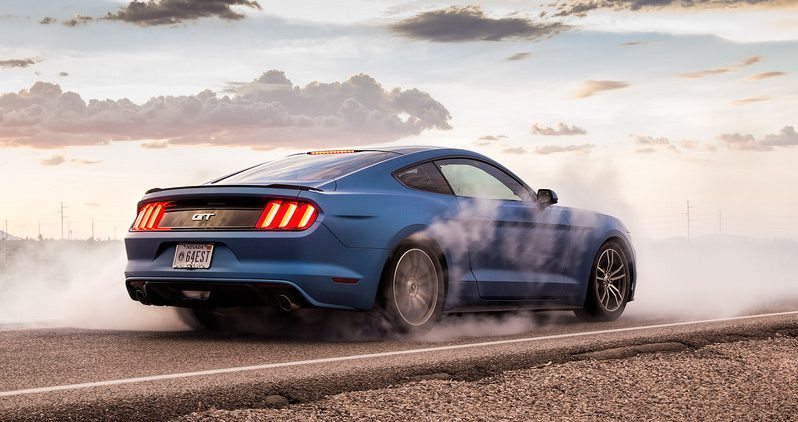A car burnout is an addictive act in a car that should only be performed within a safe location. Not only is a burnout illegal but it can also go horribly wrong and end up injurying passengers, spectators or yourself.
A burnout is much easier to achieve in an automatic as opposed to a manual car because you don’t need to deal with a clutch. The more torque and horsepower your car have will make it easier for the car to lose traction.
There are some cars that have a dedicated driving mode that will make burnouts even easier. A great example of this is the new Ford Mustang that has a burnout mode, which Ford call a “Line Locking” mode.
Don’t believe what you read online stating that you need thousands of horsepower in order to do a burnout. This is not true.
Table of Contents
How do you do a Burnout in an Automatic?
To do a burnout in an automatic car is fairly simple and can be achieved by following these six steps below:
- Find a Safe Location with no obstacles
- Point Wheels Directly Forwards
- Turn off Traction Control
- Press and Hold the Brake Pedal as Hard as Possible
- Press Gas Pedal as Hard as Possible
- Lets The Tires Burn Away!
Its important to note that a burnout usually fails due to 2 reasons. The most common reason is that the traction control is not turned off. The computer will switch off maximum power temporarily to regain traction, thus preventing a burnout.
Another reason for not being able to do a burnout is because your car hasn’t got enough power to lose grip. I personally can do burnouts in cars with over 100 BHP but its possible to do burnouts with cars of any power. If you have a low power car, make the surface that you are doing a burnout more slippery.
I often hear that Diesel cars are harder to do burnouts in. This is the complete opposite. Diesel cars have more lower down power and torque, which is perfect for initializing the spinning of the wheels. The only drawback of doing a burnout in a diesel is the “tractor” like noise roaring from the engine as opposed to the loud petrol sound we all love.
We can’t write an article on “how to do a burnout” without an example of doing one ourselves can we now?
Below we are doing a burnout on private land in an old diesel Mercedes E Class with an open diff. This is proof that you don’t need the newest car with thousands of horsepower to light those tires up!
How to Make a Burnout Easier in an Automatic?
- Look for an area with “some” loose gravel to help the car lose traction
- Add water to increase “slipperiness” for the tires
- Ensure traction control is completely off (not in “semi” off mode)
- Ensure front tires have maximum grip (rear tires if FWD burnout)
- Ensure you have the best brake pads to increase stopping power
- Follow the 6 step guide above in order
Why Does Only One Tire Spin During a Burnout?
One of the most common questions asked when performing burnouts, wheel spins or donuts. 9 times out of 10, this is simply because your car has an open differential. This has the effect of sending the majority of the cars power output to one wheel that has the lest amount of resistance.
To ensure that both wheels will spin when doing a burnout or wheel spin, you will need a LSD (Limited Slip Differential). A LSD will send power to both wheels in equal chunks and both wheels will spin during a burnout.
You can force an open differential to spin both wheels by welding it. A welded diff is where the spider gears have been welded together that allows the wheels to rotate at different speeds. This has the effect of the car understeering a lot more, which is very popular with drifters.
Welding your differential is a cheap way to get started into drifting your car or doing burnouts but it is not recommended. For daily driving, a welding differential can increase vibration and make parking harder with a “skipping” effect.
What Will Break Doing a Burnout in an Automatic?
The majority of automatic cars are not meant for doing burnouts. However, this is not to say that they will explode whenever you do one. Its important that you check your cars health before doing a burnout. If you know a particular car part is on the way out, do you really want to be doing a burnout?
For starters, your tires will take the worst amount of punishment from doing a burnout. There is often a misconception that using affordable winter tires is the best way to do a burnout (and to drift on).
However, you are simply increasing the cost of doing a burnout, stick to the cheapest or part worn tires. Winter tires are also use a soft compound rubber and when used during a burnout, chunks of rubber can break apart from the tire.
The most expensive thing to go wrong that will cost you big time after a bad burnout is your gearbox, clutch or differential. Although if you are doing a burnout fairly rarely, you will not hit these problems, especially if you car is serviced correctly and has good health.
However, if you are doing burnouts daily in a car that has driven to the moon and back, don’t be surprised if a major part breaks.
Are Car Burnouts Illegal?
Almost certainly YES. Performing a burnout in your car on the public road will be deemed as reckless driving. If you are caught by a police officer, you should expect a big telling off and of course a hefty fine. In terms of excuses, there are not many out there if you are caught doing a burnout. If you know any, let us know in the comments below!
Keep burnouts to private roads/land or on the track and within a safe environment. Everyone enjoys a burnout but safety is paramount and the fun will stop immediately as soon as someone get hurt.

